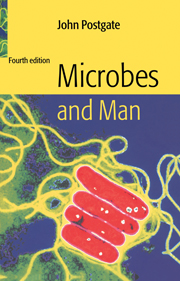Book contents
- Frontmatter
- Contents
- Illustrations
- Preface
- 1 Man and microbes
- 2 Microbiology
- 3 Microbes in society
- 4 Interlude: how to handle microbes
- 5 Microbes in nutrition
- 6 Microbes in production
- 7 Deterioration, decay and pollution
- 8 Disposal and cleaning-up
- 9 Second interlude: microbiologists and man
- 10 Microbes in evolution
- 11 Microbes in the future
- Further reading
- Glossary
- Index
7 - Deterioration, decay and pollution
Published online by Cambridge University Press: 18 December 2009
- Frontmatter
- Contents
- Illustrations
- Preface
- 1 Man and microbes
- 2 Microbiology
- 3 Microbes in society
- 4 Interlude: how to handle microbes
- 5 Microbes in nutrition
- 6 Microbes in production
- 7 Deterioration, decay and pollution
- 8 Disposal and cleaning-up
- 9 Second interlude: microbiologists and man
- 10 Microbes in evolution
- 11 Microbes in the future
- Further reading
- Glossary
- Index
Summary
I am the proud father of a family, one which has grown up and has, indeed, extended our lineage into a new generation. So my own children are encountering a result of the noble estate of parenthood which, to me at least, was quite unexpected. But it will become familiar to them, and to readers who find themselves in a comparable position: it is the amount of junk that accumulates in the house. (I hasten to add, lest one of my grandchildren should read this, that I know it is not junk to them: every celluloid duck, plastic brick, fluffy rabbit, coloured felt-tip, pop record, decayed transistor, pop-art wall poster is known personally to each offspring, complete with history and ownership.) When I was young, toys had a finite, almost predictable lifetime: a clockwork train, for example, would break, be repaired a couple of times, then find its way to a dustbin – within weeks if one was unlucky, in months on an average, in years if one was careful or the toy was particularly good. Today, it seems, toys are indestructible. Bouncer, my forty-four-year-old daughter's brushed nylon washable cuddly-dog is two years younger than its proprietor, having survived for five average lifetimes of the pre-war teddy bear and, albeit a trifle battered, is well set to accompany my granddaughters into adult life. Well, as far as Bouncer and my descendants are concerned, I am happy for all of them; it is the great number of objects of uncertain function, usually fashioned from some kind of plastic, bent, with screws missing, that leaves me with the impression that, in another decade, whole rooms of people's houses will be given over to the storage of beloved toys belonging to beloved offspring!
- Type
- Chapter
- Information
- Microbes and Man , pp. 243 - 269Publisher: Cambridge University PressPrint publication year: 2000



